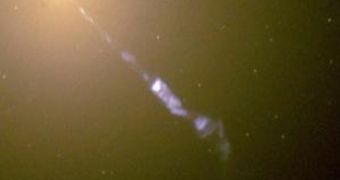Recreating jets of charged particles in the laboratory is no easy task, but an international team of researchers has announced in a recent issue of the Astrophysical Journal Letters that they have managed to do just that. The research has major implications on the way astrophysicists will look at emissions coming from forming stars and galaxies, and could offer new insight into what triggers these formations.
According to astronomical observations, astrophysical emissions are the largest and most powerful phenomena in the known Universe, as they are ejected from forming stars and black holes alike, and can travel for hundreds of thousands of light-years in all directions, affecting everything in their path. In the case of supermassive black holes, which are present at the middle of each self-respecting galaxy, these emission jets travel nearly at the speed of light.
This makes them extremely dangerous and hard to avoid or divert if, say, the black hole in the middle of the Milky Way should decide to spill out such dejections. On the other hand, smaller stars forming near galactic cores or in stellar nurseries give off far less intense emissions and pose no danger to the other celestial bodies around them.
But one of the main things that has always puzzled scientists concerning these jets is the fact that they are not continuous, in that they emit at various intensities and completely at random, as far as time goes. Experts believe that this happens because the amount of matter feeding the stars or the black holes doesn't fall smoothly inside, but in clumps.
“This is the first time we can actually produce episodic behavior. The experiment shows jets can propagate very far, but they can be quite unstable at the source,” Andrea Ciardi, a plasma physicist at the Ecole Normal Superieure, in Paris, tells New Scientist.
By feeding more than 100 billion watts of power into electrodes, connected to each other by means of an aluminum foil, the team managed to accomplish two things. First, they created a magnetic field above the foil, and then they melted the foil with the vast amount of electrical power. As that happened, the magnetic field accelerated the resulting plasma, sending it hurling around the magnetic field at hundreds of kilometers per second, a speed comparable with that of genuine emissions.
In addition, whenever a piece of aluminum broke off, it would turn into plasma and get accelerated at nearly the speed of light. This model is also compliant with that scientists see in the Universe, where emissions are fragmented in both duration and intensity. Previous attempts at simulating the conditions that lead to astrophysical emissions have proven to be flawed, as they have not accounted for all the phenomena going on inside a rising star or a black hole. The only way to get enough answers has been to recreate the event.

 14 DAY TRIAL //
14 DAY TRIAL //